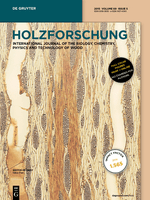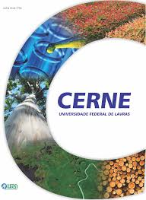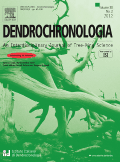
HOLZFORSCHUNG
Scope & Guideline
Pioneering insights into biomaterials from wood.
Introduction
Aims and Scopes
- Wood Degradation and Preservation Techniques:
Research in this area focuses on understanding the biological and chemical processes that lead to wood degradation, as well as exploring various preservation techniques to enhance wood durability and resistance against fungi, insects, and environmental factors. - Mechanical and Physical Properties of Wood:
This includes studies on the mechanical behavior, density, dimensional stability, and other physical characteristics of different wood species under various environmental conditions and treatments. - Wood Chemistry and Biochemistry:
Investigations into the chemical composition of wood, including lignin, cellulose, and hemicellulose, are central to understanding wood properties and developing new materials and treatments. - Wood Modification and Engineering:
This scope encompasses innovative methods for modifying wood to enhance its properties, including thermal, chemical, and physical treatments aimed at improving performance in specific applications. - Sustainable Use of Wood Resources:
The journal promotes research on sustainable forestry practices and the utilization of wood as a renewable resource, emphasizing the environmental impact and life cycle assessments. - Technological Innovations in Wood Processing:
Papers often explore new technologies and methodologies for wood processing, including advances in machinery, techniques for improving yield, and innovative applications in construction and manufacturing.
Trending and Emerging
- Advanced Analytical Techniques in Wood Research:
There is a growing trend towards employing sophisticated analytical techniques such as NMR, X-ray tomography, and machine learning to study wood properties and behaviors, indicating a shift to more data-driven research. - Sustainable Wood Processing and Biorefinery Concepts:
Research focusing on sustainability, including the development of biorefinery processes and eco-friendly treatments for wood, is gaining traction as environmental concerns become more pressing. - Nanotechnology in Wood Modification:
The integration of nanotechnology for enhancing wood properties and durability is an emerging theme, with studies exploring the use of nanoparticles in wood treatments and composites. - Interdisciplinary Approaches in Wood Science:
The journal is increasingly publishing interdisciplinary studies that combine wood science with fields like materials science, environmental science, and bioengineering, reflecting a holistic approach to wood research. - Digital and Computational Modeling of Wood Properties:
Emerging themes include the use of digital modeling and simulations to predict wood behavior under various conditions, which is becoming a vital tool for researchers and engineers.
Declining or Waning
- Traditional Wood Species Identification Methods:
While previously a significant focus, the reliance on traditional methods for identifying wood species has diminished with the rise of advanced techniques such as DNA barcoding and machine learning, leading to less frequent publications in this area. - Basic Wood Anatomy Studies:
Research strictly focused on the anatomical features of wood, while still relevant, is less frequently published as studies increasingly incorporate complex biochemical and physical analyses. - General Reviews on Wood Properties:
General review articles summarizing well-established knowledge on wood properties are becoming less common as the journal shifts towards more innovative and specific studies that explore novel findings and applications. - Simple Mechanical Testing of Wood:
Basic mechanical testing without advanced analytical techniques is seeing a decline as research shifts toward more comprehensive studies that integrate multiple variables and technologies. - Historical and Archaeological Studies of Wood:
Research focused on the historical aspects of wood use or archaeological findings, while still present, is less prominent in recent issues as the journal emphasizes more contemporary applications and technologies.
Similar Journals

Cerne
Connecting Knowledge and Nature for Sustainable SolutionsCerne is a distinguished open-access journal dedicated to advancing knowledge in the field of forestry, published by the Universidade Federal de Lavras (UFLA). Since its inception in 1994, the journal has actively contributed to the global discourse on sustainable forest management and biodiversity conservation, presenting research findings that are both relevant and impactful. With its ISSN 0104-7760, Cerne aims to foster collaboration among researchers, professionals, and students, enhancing the understanding of forestry practices in Brazil and beyond. As of 2023, it holds a respectable Q3 ranking in the forestry category, further cementing its position within the academic community, illustrated by a Scopus ranking of #97 out of 174 in the Agricultural and Biological Sciences - Forestry field. Operating under an open-access model allows for wide dissemination of research outputs, ensuring that critical findings reach a broad audience, fueling further innovation and discovery in the field. With converged years extending from 2007 to 2024, Cerne continues to be a vital resource for anyone engaged in forestry research and practices.

DENDROCHRONOLOGIA
Advancing Knowledge on Climate and EcologyDendrochronologia is a prestigious journal dedicated to the study of tree rings and their implications for understanding environmental changes, climate variability, and ecological dynamics. Published by Elsevier GmbH in Germany, it has consistently reached high academic standards, holding a remarkable Q1 ranking in both Ecology and Plant Science as of 2023, demonstrating its significant impact within these fields. The journal aims to foster interdisciplinary dialogue through the dissemination of original research, reviews, and methodological advancements related to dendrochronology, appealing to researchers, students, and professionals who seek to deepen their knowledge of the interactions between terrestrial ecosystems and climate change. Although it does not currently offer an open access option, Dendrochronologia remains an essential resource for those in the scientific community, with valuable insights that contribute to the understanding of biodiversity and ecological resilience.

European Journal of Wood and Wood Products
Fostering collaboration in the global wood industry.The European Journal of Wood and Wood Products, published by Springer, serves as a pivotal platform for scholarly communication within the fields of Forestry and Materials Science. With a proud history that dates back to its initial publication in 1937, this journal has continuously evolved, addressing cutting-edge issues and advancements in wood science and technology. It currently holds a Q2 ranking in both Forestry and Materials Science categories, indicating its significant impact and reputation among researchers, as evidenced by its high rankings in Scopus, where it is placed 27th in Forestry and 167th in General Materials Science. The journal's open access options foster greater dissemination of research findings, supporting the global wood industry and related scientific communities. As it continues to publish high-quality research through 2024, the European Journal of Wood and Wood Products remains an essential resource for those looking to stay at the forefront of wood-related research and innovation.

Acta Facultatis Xylologiae Zvolen
Advancing forestry research with every publication.Acta Facultatis Xylologiae Zvolen, an esteemed journal published by TECHNICKA UNIV ZVOLENE, serves as a pivotal platform for the dissemination of research within the field of Forestry. With an ISSN of 1336-3824, this journal has been consistently delivering scholarly articles since its inception in 2007. It is recognized in Scopus, placing it in the Q3 category among its peers in Agricultural and Biological Sciences, specifically in Forestry, wherein it ranks #80 out of 174 with a 54th percentile. Although currently not open access, it provides critical insights and high-quality research that are invaluable for professionals, researchers, and students engaged in forestry and related disciplines. Readers can expect to find articles that delve into contemporary issues, innovative methods, and emerging trends within the field, making it an essential resource for anyone devoted to advancing the science of forestry.

WOOD RESEARCH
Unveiling Insights for a Sustainable Forest FutureWOOD RESEARCH is a premier academic journal published by the SLOVAK FOREST PRODUCTS RESEARCH INSTITUTE, dedicated to advancing knowledge in the fields of forestry and material science. With an ISSN of 1336-4561, this journal serves as a vital resource for researchers and professionals seeking to explore innovative research, advancements in wood technology, and sustainable practices related to forest products. Recognized for its quality, WOOD RESEARCH holds a Q2 ranking in the field of Forestry and a Q3 ranking in Materials Science according to the latest metrics, indicating a robust contribution to these disciplines. The journal is committed to open access options, ensuring that findings are accessible to a global audience, thereby fostering collaboration and knowledge sharing. Established in 2003 and operating through to 2024, it continues to play a significant role in shaping the future of wood research, offering insights that are essential for students, academics, and industry leaders alike. For detailed submissions and research discussions, the journal can be accessed through its dedicated platform, contributing to an enriched academic dialogue in Slovakia and beyond.

Scientia Forestalis
Exploring the depths of forest ecosystems and their complexities.Scientia Forestalis is a prominent academic journal dedicated to advancing the field of forestry and environmental studies. Established in 1996 and published by the Instituto de Pesquisa e Estudos Florestais (IPEF) in Brazil, this journal provides a critical platform for researchers and practitioners to disseminate innovative studies and findings in forestry. With an HIndex reflective of its academic impact and ranking in the third quartile of forestry journals, Scientia Forestalis is positioned to cater to a diverse audience, including scholars, professionals, and students engaged in agricultural and biological sciences. Despite its non-open access model, the journal maintains a commitment to high-quality research that fosters an understanding of forest ecosystems and sustainable practices. Published articles span a wide range of topics, ensuring that crucial developments in forestry science are captured and shared. The journal's current Scopus rank places it within the 26th percentile, affirming its role in shaping forestry research in a global context, making it an essential resource for anyone interested in this vital field.

FOREST PRODUCTS JOURNAL
Pioneering research for the preservation of our forests.FOREST PRODUCTS JOURNAL is a prestigious publication dedicated to the advancement of knowledge in the field of forestry and forest products. Published by the Forest Products Society, this journal has established itself as a significant resource since its inception in 1968, offering valuable insights into the scientific, engineering, and technological aspects of wood products. With a commendable impact factor and categorized as Q2 in Forestry and Q3 in both Materials Science and Plant Science, it serves as an essential platform for researchers, professionals, and students alike. The journal's comprehensive scope covers topics from sustainable forestry practices to innovative material applications and forest management strategies, addressing critical challenges faced in the industry. Although it is not an Open Access journal, interested readers can access its contents through numerous academic databases, ensuring widespread availability to foster collaboration and advancement in forest-related sciences. The FOREST PRODUCTS JOURNAL is not only crucial for knowledge dissemination but also for promoting the sustainability and conservation of forest resources globally.

Kastamonu University Journal of Forestry Faculty
Enhancing scientific discourse in forestry and environmental stewardship.Kastamonu University Journal of Forestry Faculty, published by KASTAMONU UNIV, is a prestigious open-access journal dedicated to advancing knowledge in the field of forestry and environmental sciences. Established in 2001, this journal provides a vital platform for researchers, professionals, and students to share their findings and insights on topics such as sustainable forest management, ecological restoration, and forestry education. Its commitment to open access ensures that groundbreaking research is readily available to a global audience, fostering collaboration and innovation in the field. Although specific metrics such as HIndex are currently not available, the journal continues to strive towards increasing its visibility and impact within academic circles. With a strong focus on promoting scholarly exchange, the Kastamonu University Journal of Forestry Faculty plays a crucial role in enhancing the scientific discourse surrounding forestry issues at both local and international levels.

WOOD SCIENCE AND TECHNOLOGY
Advancing the Frontiers of Wood Science and TechnologyWOOD SCIENCE AND TECHNOLOGY, published by SPRINGER, is a premier academic journal dedicated to the multidisciplinary study of wood and its applications. With a rich history spanning since its inception in 1967 and continuing through 2024, this journal plays a vital role in advancing our understanding of forestry, industrial and manufacturing engineering, and materials science. It enjoys an impressive categorization in the 2023 rankings, securing a Q1 status in Forestry and notable Q2 rankings in Industrial and Manufacturing Engineering, Materials Science, and Plant Science. Researchers and professionals benefit from its rigorous peer-reviewed articles, making substantial contributions to the field. The journal is actively indexed, ensuring high visibility and access to its content, which is essential for anyone looking to stay at the forefront of wood science research. The current impact factors and rankings affirm its significance, making it a critical resource for academics seeking to foster innovation and collaboration in wood technology and related disciplines.

JOURNAL OF TROPICAL FOREST SCIENCE
Innovating Conservation Strategies for Tropical EcosystemsThe JOURNAL OF TROPICAL FOREST SCIENCE, published by the FOREST RESEARCH INST MALAYSIA, serves as a vital platform for disseminating research focused on tropical forestry. Since its inception in 1988 and transitioning to its current form in 1993, this journal has established itself within the academic community, currently holding a commendable Q3 ranking in the Forestry category, as per the 2023 metrics. With an ISSN of 0128-1283 and E-ISSN 2521-9847, it provides crucial insights into the ecological, economic, and social aspects of tropical forest management and conservation, making it an indispensable resource for researchers, practitioners, and students alike. Although it does not operate under an open-access model, the journal emphasizes quality and relevance in its publications, contributing significantly to the ongoing discourse in agricultural and biological sciences with a Scopus rank of #89 out of 174 and a 49th percentile position.